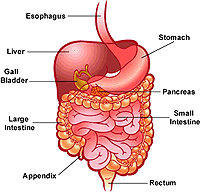 The
digestive system consists of a long muscular tube, extending from
mouth to anus, and a large number of associated glands which secrete
substances that aid food digestion. The digestive tube is generally
made up of four structurally and functionally distinct layers: the
mucosa, the submucosa, the muscularis, and the serosa (or the
adventitia, if not covered by mesothelium). The mucosa, which is in
contact with the luminal contents, is constructed to resist abrasion
and to perform secretory and absorptive functions. The muscular
layer which serves to propel the food through the tube is attached
to the mucosa by way of a loose CT layer, the submucosa. The serosa
or adventitia carries blood vessels and nerves to the wall of the
digestive tube. The
digestive system consists of a long muscular tube, extending from
mouth to anus, and a large number of associated glands which secrete
substances that aid food digestion. The digestive tube is generally
made up of four structurally and functionally distinct layers: the
mucosa, the submucosa, the muscularis, and the serosa (or the
adventitia, if not covered by mesothelium). The mucosa, which is in
contact with the luminal contents, is constructed to resist abrasion
and to perform secretory and absorptive functions. The muscular
layer which serves to propel the food through the tube is attached
to the mucosa by way of a loose CT layer, the submucosa. The serosa
or adventitia carries blood vessels and nerves to the wall of the
digestive tube.The large
number of glands associated with the digestive canal range from
unicellular components and small tubuloalveolar units residing in
the mucosa to very large organs such as the pancreas and liver.
Although their secretions can be quite dissimilar, they all function
to promote the digestive process by imparting enzymes or mucus into
the ingested food. Bile, the exocrine secretion of the liver, is
stored and concentrated in another organ, the gall bladder.
Learning Objectives:
- Recognize and understand the
general structural characteristics of the gastrointestinal
tract: mucosa, submucosa, muscularis, and serosa.
- Understand the regions and parts
of a tooth and how these structures are formed.
- Understand the functional
significance of structures associated with the tongue.
- Recognize and understand the
function of the different glands associated with the
gastrointestinal tract.
- Recognize the various regions of
the gastrointestinal tract (esophagus, stomach, small and large
bowels), the major specific cell types specific to each region
and how they contribute to digestive function.
- Understand the structure and
exocrine function of the pancreas.
- Understand the micro
architecture and functions of the liver with regard to its
circulatory system and the production of bile. Recognize the
structure and function of the gall bladder.
Let's start with the
oral cavity. |